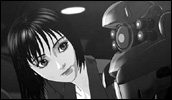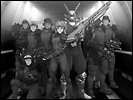Appleseed
- Year
- 2004
- Original title
- Appurushido
- Japanese title
- アップルシード
- Director
- Cast
- Running time
- 105 minutes
- Published
- 17 May 2008



by Paul Jackson
The western distributors of Shinji Aramaki's Appleseed seem keen to identify the film as being from the creator of Ghost in the Shell. They are not referring to Mamoru Oshii, director the 1995 anime, but to Masamune Shirow, author of the source manga for both franchises. Despite lofty aspirations Aramaki's film falls dramatically short of both. In truth Appleseed has more in common with Kazuaki Kiriya's live action Casshern (2004) and countless sci-fi blunders that are routinely associated with Hollywood's major studios: replete with resplendent visuals but lacking engaging characters and narrative cohesion. But whereas Appleseed's Hollywood kin often fade into obscurity, Aramaki's film is a prime example of how anime's comparative niche appeal can afford a film success despite limited merits.
The film takes place in and around Olympus, Earth's last surviving utopia following the devastation of World War 3. A lengthy exposition scene reveals that the city is governed by Gaia, a supercomputer which in turn is maintained by a council of seven elders. In Olympus humans live alongside Bioroids, an artificially created race that look identical to humans but are unable to reproduce and can't experience love. Simmering tensions between the two races literally explode when a Bioroid production facility is attacked. In true end-of-the-world fashion, protagonist Deunan Knute must race against time to save humanity, albeit without the irony or wit audiences might expect.
Sold as groundbreaking when originally released in 2004, Appleseed utilizes computer generated animation, produced using motion capture technology and cel shading, but goes to great lengths to reproduce anime's stylistic hallmarks. Like their hand-drawn counterparts, characters retain their nymph-like features but are rendered three dimensional and set against realistic backgrounds. Unfortunately, the CG animation has dated dramatically. At its worst, Appleseed looks and feels like a scene cut from a video game. Ironically, for a story that presents a society able to artificially produce life, human characters are animated in a style that makes them appear lifeless and robotic. The film's mechanical designs, however, are much more suited to CG animation. Shirow's painstakingly detailed combat armour and other future technologies have been reproduced (and updated) to an exacting degree, offering at least some weight to an otherwise underdeveloped future society.
In terms of narrative, Appleseed is again flawed. Although superficially faithful to Shirow's superior manga - major plot points remain as does much of the overarching story - Aramaki's adaptation overlooks many traits that enriched the original. Deunan's relationship with Briereos, her cyborg partner with curious mechanical rabbit ears, is a telling example. In the manga the duo served as the backbone to the story, serving as our introduction to Olympus as they are reacquainted to a world thought lost during WWIII. Using the conventions of countless buddy movies, novels and comics, Shirow injected humour into the story, offering a necessary contrast to the political intrigue of his future world. Briereos was similarly imbued with an amiable charm through a range of hang-dog expressions (again lost in this update). Aramaki re-imagines this core relationship, repositioning Deunan and Briereos as icy ex-lovers culminating in a cliched heroic sacrifice and resurrection. The supporting character of Hitomi is similarly reduced to cliche as artificial life that longs to know love. These alterations strip Appleseed of the humanity that crucially anchored the story's science fiction elements. What remains is a thoroughly underwhelming action film that favours guns and explosions over character and setting.
Despite these shortcomings Appleseed found a big enough audience to justify a sequel, Appleseed: Ex Machina (2007), co-produced by John Woo and again directed by Aramaki.